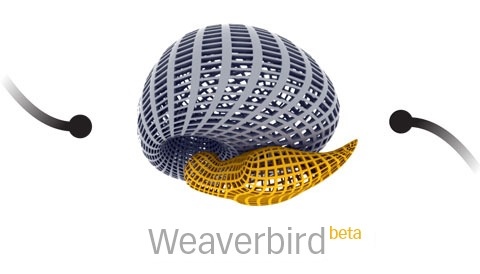Weaverbird is a topological modeler that contains many of the known subdivision and transformation operators, readily usable by designers. Instead of doing the work repeatedly, or sometimes using complicated scripts, this plug-in reconstructs the shape, subdivides any mesh, even made by polylines, and helps preparing for fabrication.
Weaverbird – 0.9.0.1 No expiry. For Rhino 4/5 and Grasshopper 0.9. In wb toolbar. Please upgrade to this version if you are using any earlier releases. This version will NOT expire.
To install, right click, choose “save as…” and then double click the file to launch the setup. If you encounter any problem contact me with a comment.
If you don’t have admin rights (you will find instructions in the zip file).
Main topological commands:
 Catmull-Clark smoothing (wbCatmullClark). Calculates the type of mesh-based recursive subdivision described by Edwin Catmull and Jim Clark, at first in 1978. The resulting mesh always consists of quadrilaterals.
Catmull-Clark smoothing (wbCatmullClark). Calculates the type of mesh-based recursive subdivision described by Edwin Catmull and Jim Clark, at first in 1978. The resulting mesh always consists of quadrilaterals.
 Split mesh into Quads (wbSplitQuad). Calculates a new mesh, which is formed of only quads and generally appears similar to the old one, except that it is welded. It is topologically equivalent to the Catmull-Clark subdivision.
Split mesh into Quads (wbSplitQuad). Calculates a new mesh, which is formed of only quads and generally appears similar to the old one, except that it is welded. It is topologically equivalent to the Catmull-Clark subdivision.
 Loop smoothing (wbLoop). Calculates the type of mesh-based recursive subdivision described by Charles Loop, at first in his Mathematics thesis in 1987. The resulting mesh always consists of triangular faces.
Loop smoothing (wbLoop). Calculates the type of mesh-based recursive subdivision described by Charles Loop, at first in his Mathematics thesis in 1987. The resulting mesh always consists of triangular faces.
 Split mesh with inner face (wbSplitPolygons). Places a new face departing from the middle of each original face edge. Caps the remaining hole with Sierpinski triangles.
Split mesh with inner face (wbSplitPolygons). Places a new face departing from the middle of each original face edge. Caps the remaining hole with Sierpinski triangles.
 Sierpinsky Triangles subdivision (wbSierpinskyTriangle). Places a triangle in each corner of a mesh face. The mesh will have one more hole per face.
Sierpinsky Triangles subdivision (wbSierpinskyTriangle). Places a triangle in each corner of a mesh face. The mesh will have one more hole per face.
 Frame (wbFrame). Computes a new mesh with higher naked edge count, where each face has a new hole in the center and resembles a picture frame. The resulting mesh always consists of quad faces.
Frame (wbFrame). Computes a new mesh with higher naked edge count, where each face has a new hole in the center and resembles a picture frame. The resulting mesh always consists of quad faces.
 Carpet (wbCarpet). Computes a new mesh with higher naked edge count, where each face has a new hole in the center. The resulting mesh always consists of quad faces, and can be used to compute a Sierpinski carpet.
Carpet (wbCarpet). Computes a new mesh with higher naked edge count, where each face has a new hole in the center. The resulting mesh always consists of quad faces, and can be used to compute a Sierpinski carpet.
 Window (wbWindow). Replaces each original mesh face with a new one, reconstructed on the inside. Each face has the same number of sides as the original one.
Window (wbWindow). Replaces each original mesh face with a new one, reconstructed on the inside. Each face has the same number of sides as the original one.
New mesh primitives definitions:
 wbPrism,
wbPrism,  wbAntiPrism,
wbAntiPrism,  wbPyramid,
wbPyramid,  wbDiPyramid
wbDiPyramid
Additional commands:
- wbOptions. To see the main log, set up the threading model, control the maximum time a single operation is allowed to take, and set options for the Loop subdivision scheme (to use Loop’s receipt or Warren-Weimer’s one).
- wbProperties. Opens a window with topological information about any mesh object in Rhino. Exposes triangular and quad face counts, edge count, current and welded vertex counts.
